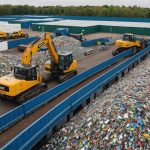The oil pipeline sector is undergoing a transformative shift, integrating advanced technologies and innovative practices to enhance safety, efficiency, and sustainability. With growing environmental concerns and economic pressures, new solutions are emerging to address the complexities of oil transportation. Explore how cutting-edge developments are not only reshaping the industry but also paving the way for a more resilient and eco-conscious future in oil pipeline management.
Overview of Oil Pipeline Infrastructure
Oil pipeline infrastructure forms the backbone of global energy distribution, enabling the efficient transportation of crude oil and refined products from production sites to refineries and ultimately to consumers. When nations consider oil pipeline investments, they recognize their critical role in energy security and economic stability. These pipelines range from onshore systems stretching thousands of miles across continents to complex offshore networks beneath oceans.
Additional reading : Essential branding tactics for uk fitness coaches to build a compelling personal identity
Mechanisms of Oil Transport Systems
Oil pipelines operate using an intricate system of pump stations, pipeline segments, and monitoring technologies. Crude oil pipelines transport unrefined oil to refineries, while product pipelines carry refined goods like gasoline, diesel, and kerosene. To prevent substance mixing, advanced mechanisms ensure batch integrity, maintaining product quality. Drag-reducing agents are often used to enhance flow efficiency while minimizing corrosion and operational costs.
Economic Implications of Oil Pipelines
The economic benefits of oil pipelines are undeniable. Transportation via pipelines is significantly more cost-effective compared to alternatives such as rail or trucking. For example, the global average cost of moving crude oil by pipeline hovers around $5 per barrel—drastically lower than the $10-$15 per barrel for rail. This affordability spurs investment opportunities, with thousands of miles of new pipeline construction planned to meet rising global energy demand. Such developments drive local economies by generating employment and fostering growth in resource-dependent regions.
Additional reading : Unlocking efficiency: the power of facility management software
Safety and Regulations in Oil Pipelines
Safety Standards and Protocols
Oil pipeline safety standards are designed to protect both the environment and communities. These protocols include regular inspections, advanced monitoring systems like “smart pigs,” and drag-reducing additives to minimize corrosion. Steel pipelines are typically coated to prevent external rust, a feature critical in safeguarding long-term performance. Offshore pipelines add complexity with their materials and insulation, tailored to withstand underwater pressures.
Compliance with Regulations
Adherence to oil pipeline regulations is essential for smooth operations. Operators must maintain readiness to detect leaks promptly, with standards requiring pinpointing 8% of maximum flow leaks within 15 minutes. Training programs ensure response efficiency, limiting risks tied to human error. Environmental assessments, mandated by regulations, focus on reducing the environmental impact of leaks and construction.
Monitoring Technologies for Pipeline Integrity
Sophisticated oil pipeline monitoring systems enhance integrity management. These include aerial surveillance, thermal sensors, and automated leak detection technologies, which have become integral for modern infrastructure. Such advancements align with global efforts to mitigate pipeline failures, making them increasingly reliable for crude oil and petroleum product transport.
Challenges and Innovations in Oil Pipeline Management
Common Challenges in Pipeline Operations
Oil pipeline operations face numerous hurdles, ranging from natural wear to external threats. Corrosion remains one of the most pressing concerns, as it weakens pipelines over time and increases the risk of leaks or ruptures. Additionally, third-party interference, such as accidental damage from construction activities, poses a serious danger. Environmental factors like seismic activity or flooding further intensify challenges, particularly for offshore oil pipelines, which endure harsher conditions.
Strict oil pipeline regulations compel operators to mitigate these risks by adhering to defined safety and monitoring standards. Consistent compliance is demanding and necessitates advanced pipeline monitoring systems to detect anomalies swiftly.
Recent Technological Innovations in Pipelines
Advances in oil pipeline technological innovations have substantially transformed operations. For instance, drag-reducing agents enhance the efficiency of fluid transportation, minimizing energy expenditure. High-resolution pipeline mapping technologies now allow for precision during pipeline construction and maintenance, reducing the likelihood of errors.
Robust pipeline leak detection technologies further contribute to operational safety. Using smart sensors and AI-driven algorithms, these systems can identify cracks or pressure changes. Coupled with automated response systems, they minimize environmental risks associated with leaks.
Strategies for Risk Assessment and Management
Implementing comprehensive oil pipeline risk assessment methodologies is essential. This includes routine inspections, leveraging oil pipeline monitoring systems, and adopting non-invasive techniques such as “smart pigs” to identify structural weaknesses. Operators increasingly rely on predictive models powered by AI to analyze potential vulnerabilities based on environmental and operational data.
Case Studies and Future Trends in Oil Pipelines
Analysis of Major Pipeline Projects and Their Impact
The United Kingdom Oil Pipelines (UKOP) system serves as a prime example of effective oil transport systems. Established in 1969, it connects Shell’s Stanlow refinery to other critical installations, moving 7.5 million tonnes of mixed oil products annually. These include kerosene, certain petrol grades, and gas oil. Its strategic setup highlights the role of pipelines in ensuring reliable oil supply routes, benefiting not only local economies but also global oil distribution networks.
In the United States, historical projects like the “Big Inch” pipelines demonstrate how wartime demands spurred innovation in oil pipeline infrastructure. These pipelines supported crude oil transportation from production fields to refineries, pioneering long-distance energy logistics.
Environmental Assessments and Challenges
Oil pipeline projects must rigorously address environmental impacts through comprehensive assessments. Marine pipelines, often essential for cross-border oil pipelines, pose unique risks to marine ecosystems. Regulations enforce strict safety standards to ensure minimal disruption, yet pipeline construction in remote areas faces challenges like habitat destruction and operational complexities.
Predictions for the Future Development of Oil Pipelines
Emerging technologies, like pipeline monitoring systems, are reshaping the future of oil pipelines. Innovations focus on reducing pipeline failures and disasters while enhancing efficiency. Additionally, shifts toward sustainable energy may influence investment in alternative transportation options, balancing economic benefits with climate policy demands.











